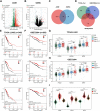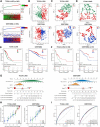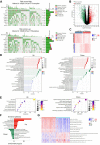KIF20A is associated with clinical prognosis and synergistic effect of gemcitabine combined with ferroptosis inducer in lung adenocarcinoma
- PMID: 36225575
- PMCID: PMC9549118
- DOI: 10.3389/fphar.2022.1007429
KIF20A is associated with clinical prognosis and synergistic effect of gemcitabine combined with ferroptosis inducer in lung adenocarcinoma
Abstract
Gemcitabine (GEM), an antimetabolite that terminates DNA synthesis, is commonly used in the treatment of cancers including lung adenocarcinoma (LUAD). However, downregulation of sensitivity limits the therapeutic effect. Ferroptosis as the new form of regulated cell death has been shown to have great potential for cancer treatment with chemoresistance. Here, three genes with both ferroptosis and GEM-response-associated features were screened from RNA sequencing and public data for constructing an independent risk model. LUAD patients with different risk scores had differences in mutational landscape, gene enrichment pathways, and drug sensitivity. By Cell Counting Kit-8 assay, flow cytometry, and colony forming assay, we demonstrate that GEM and ferroptosis inducer (FIN) imidazole Ketone Erastin had a synergistic combined anti-proliferative effect on LUAD cells and knockdown of KIF20A (the core gene of our model) further enhanced cell death in vitro by inducing ferroptosis. In conclusion, we identified a link between ferroptosis and GEM response in LUAD cells and developed a robust signature that can effectively classify LUAD patients into subgroups with different overall survival. For LUAD, the combined treatment modality of GEM and FIN is potentially effective and KIF20A may be a new therapeutic target.
Keywords: KIF20A; ferroptosis; gemcitabine; lung adenocarcinoma; risk model; synergistic effect.
Copyright © 2022 He, Liang, Huang, Jiang, Liu, Sun, Li, Cong and Jiang.
Conflict of interest statement
The authors declare that the research was conducted in the absence of any commercial or financial relationships that could be construed as a potential conflict of interest.
Figures







Similar articles
-
Development and Validation of a Ferroptosis-Related Gene Signature for Overall Survival Prediction in Lung Adenocarcinoma.Front Cell Dev Biol. 2021 Jul 7;9:684259. doi: 10.3389/fcell.2021.684259. eCollection 2021. Front Cell Dev Biol. 2021. PMID: 34307361 Free PMC article.
-
A ferroptosis-related gene signature predicts overall survival in patients with lung adenocarcinoma.Future Oncol. 2021 Apr;17(12):1533-1544. doi: 10.2217/fon-2020-1113. Epub 2021 Jan 12. Future Oncol. 2021. PMID: 33432837
-
A novel ferroptosis-related genes model for prognosis prediction of lung adenocarcinoma.BMC Pulm Med. 2021 Jul 13;21(1):229. doi: 10.1186/s12890-021-01588-2. BMC Pulm Med. 2021. PMID: 34256754 Free PMC article.
-
Development and Validation of a Robust Ferroptosis-Related Prognostic Signature in Lung Adenocarcinoma.Front Cell Dev Biol. 2021 Jun 24;9:616271. doi: 10.3389/fcell.2021.616271. eCollection 2021. Front Cell Dev Biol. 2021. PMID: 34249899 Free PMC article.
-
The potential of ferroptosis combined with radiotherapy in cancer treatment.Front Oncol. 2023 Mar 17;13:1085581. doi: 10.3389/fonc.2023.1085581. eCollection 2023. Front Oncol. 2023. PMID: 37007068 Free PMC article. Review.
Cited by
-
Targeted tumor cell-intrinsic CTRP6 biomimetic codelivery synergistically amplifies ferroptosis and immune activation to boost anti-PD-L1 immunotherapy efficacy in lung cancer.J Nanobiotechnology. 2025 Jun 2;23(1):409. doi: 10.1186/s12951-025-03428-5. J Nanobiotechnology. 2025. PMID: 40457410 Free PMC article.
-
BDH1-mediated LRRC31 regulation dependent on histone lysine β-hydroxybutyrylation to promote lung adenocarcinoma progression.MedComm (2020). 2023 Dec 13;4(6):e449. doi: 10.1002/mco2.449. eCollection 2023 Dec. MedComm (2020). 2023. PMID: 38098610 Free PMC article.
-
The dual role of ferroptosis in anthracycline-based chemotherapy includes reducing resistance and increasing toxicity.Cell Death Discov. 2023 Jun 21;9(1):184. doi: 10.1038/s41420-023-01483-1. Cell Death Discov. 2023. PMID: 37344500 Free PMC article. Review.
-
KIF20A is a Prognostic Marker for Female Patients with Estrogen Receptor-Positive Breast Cancer and Receiving Tamoxifen as Adjuvant Endocrine Therapy.Int J Gen Med. 2023 Aug 21;16:3623-3635. doi: 10.2147/IJGM.S425918. eCollection 2023. Int J Gen Med. 2023. PMID: 37637711 Free PMC article.
-
Ferroptosis: mechanisms and therapeutic targets.MedComm (2020). 2024 Nov 20;5(12):e70010. doi: 10.1002/mco2.70010. eCollection 2024 Dec. MedComm (2020). 2024. PMID: 39568772 Free PMC article. Review.
References
LinkOut - more resources
Full Text Sources
Research Materials

